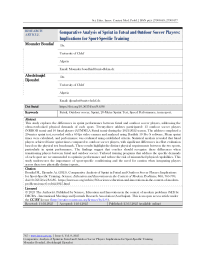Comparative Analysis of Sprint in Futsal and Outdoor Soccer Players: Implications for Sport-Specific Training
Автор: Boudiaf M., Djouabr Ai.
Журнал: Science, Education and Innovations in the Context of Modern Problems @imcra
Статья в выпуске: 6 vol.8, 2025 года.
Бесплатный доступ
This study explores the differences in sprint performance between futsal and outdoor soccer players, addressing the often-overlooked physical demands of each sport. Twenty-three athletes participated: 13 outdoor soccer players (NRBOD team) and 10 futsal players (ATM'SILA Futsal team) during the 2021/2022 season. The athletes completed a 20-meter sprint test, recorded with a 60 fps video camera and analyzed using Dartfish 10 Pro S software. Mean sprint times were calculated, and performance was evaluated using established criteria. Statistical analysis revealed that futsal players achieved faster sprint times compared to outdoor soccer players, with significant differences in effort evaluation based on the physical test benchmark. These results highlight the distinct physical requirements between the two sports, particularly in sprint performance. The findings suggest that coaches should recognize these differences when transitioning players between futsal and outdoor soccer. Tailored training programs that address the specific demands of each sport are recommended to optimize performance and reduce the risk of mismatched physical capabilities. This study underscores the importance of sport-specific conditioning and the need for caution when integrating players across these two physically distinct sports.
Futsal, Outdoor soccer, Sprint, 20-Meter Sprint Test, Speed Performance, team sport
Короткий адрес: https://sciup.org/16010823
IDR: 16010823 | DOI: 10.56334/sei/8.6.86
Текст научной статьи Comparative Analysis of Sprint in Futsal and Outdoor Soccer Players: Implications for Sport-Specific Training
RESEARCH ARTICLE Comparative Analysis of Sprint in Futsal and Outdoor Soccer Players: Implications for Sport-Specific Training Mounder Boudiaf Dr. < \ \ University of Chlef \ \ Algeria X X Abedelmajid ? Djouabri X X / Email: Dr. University of Chlef Algeria Email: Doi Serial Keywords Futsal, Outdoor soccer, Sprint, 20-Meter Sprint Test, Speed Performance, team sport.
Boudiaf M., Djouabr Ai. (2025). Comparative Analysis of Sprint in Futsal and Outdoor Soccer Players: Implications for Sport-Specific Training. Science, Education and Innovations in the Context ofModern Problems, 8(6), 765-776; doi:10.56352/sei/8.6.86. ч\\\\\\\\\\\\\\\\\\\\\\\\\\\\\\\\\\\\\\\\\\\\\\\\\\\\\\\\\\\\\\\\\\\\\\\\\\\\\\\ Licensed
© 2025 The Author(s). Published by Science, Education and Innovations in the context of modern problems (SEI) by IMCRA - International Meetings and Journals Research Association (Azerbaijan). This is an open access article under the CC BY license . Received: 11.02.2025 Accepted: 14.04.2025
Futsal and outdoor soccer exhibit a shared characteristic of high-intensity intermittent physical activities. Both sports necessitate not only aerobic capacity but also the anaerobic capabilities of players. However, a crucial distinction lies in the intensity of play. During a futsal match, the intensity frequently approaches 90% of the maximum heart rate, whereas in outdoor soccer, the intensity is generally lower, typically ranging from 80-90% of the maximum heart rate. This disparity in physiological demands underscores the unique characteristics of each sport despite their apparent similarities (Milanovi c et al., 2011).
Physical activity during futsal matches is characterized by high-intensity, multi-directional sprinting with the execution of sport-specific skills. These demands exceed those of outdoor soccer and other intermittent sports. Futsal performance is contingent upon a complex interplay between aerobic and anaerobic energy systems, emphasizing the unique physiological requirements of a sport. This combination of rapid, varied movement patterns and technical skill execution under high-intensity conditions differentiates futsal from other intermittent sports and accentuates its demanding nature (Barbero Alvarez et al., 2009).
A comprehensive understanding of futsal's distinctive physical demands is essential for the sport's advancement. The high-intensity physical exertion and repeated, intermittent maximum-speed activities inherent in futsal necessitate specialized training regimens to which players must adapt. Consequently, futsal athletes are required to develop substantial intermittent endurance capacity and proficiency in executing repeated sprints, highlighting the unique physical demands of the sport.
Furthermore, futsal's dynamic nature necessitates that athletes seamlessly transition between defensive and offensive roles, often concurrently, in response to match circumstances and immediate team requirements. This requisite adaptability not only underscores the unique nature of futsal but also highlights the inherent versatility of futsal players' capabilities, distinguishing the sport from other athletic disciplines.
Futsal's multifaceted physical and tactical demands underscore the necessity for specialized training methodologies that address these unique requirements. By recognizing and cultivating these specific attributes, coaches and athletes can enhance performance and contribute to the overall advancement of sports (Naser et al., 2017).
Futsal is characterized as a high-intensity, team-based sport with significant physiological demands. Research indicates that athletes typically cover approximately 4 km during a match, including approximately 135 m sprints at velocities exceeding 18 km/h and an average of three rapid accelerations and decelerations per minute. To excel in this sport, athletes must develop power, strength, and agility to achieve rapid linear velocities, which enhance their capacity for sprinting, abrupt deceleration, and efficient directional changes. Studies emphasize that the capacity for high-speed running and rapid accelerations/decelerations is the principal factor correlating various kinematic, mechanical, and metabolic variables. This capability is also the primary predictor of activity patterns in futsal, rendering it the most accurate and reliable indicator of high-intensity actions (HIA) within a sport (Ribeiro et al., 2023).
The evolution of futsal teams' physical, technical, and tactical aspects has amplified the competitive and dynamic nature of matches. Athletes encounter two fundamental scenarios determined by ball possession or its absence, necessitating alternation between defensive and offensive roles in response to game demands. Consequently, futsal athletes must possess essential physical attributes, including velocity, endurance, agility, and muscular strength. Contemporary research indicates that physiological characteristics are crucial determinants of high-performance efficiency, with sprint velocity (locomotor velocity) identified as a key indicator of athlete performance (de Matos et al., 2008).
This study distinguishes itself from prior research through its methodology for quantifying the recorded time of the applied physical test (20-meter sprint). Furthermore, the results were compared with the test's evaluative reference levels.
A prominent trend has been observed in futsal practices regarding the recruitment of former senior-level athletes from various divisions of outdoor football competitions. This approach persists despite the distinct physical demands, technical characteristics, and morphological requirements inherent to futsal. These athletes are directly integrated into futsal competitions without adequate consideration for the sport's unique physical and skill-based attributes.
Method
ResearchTools
This study was conducted during the 2021/2022 sports season and provides a comprehensive analysis of futsal practices in Algeria. Purposive sampling was employed to select participants from two teams competing during the 2021/2022 sporting season: Athletic M'Sila Futsal (ATM), a team consisting of 16 athletes that competes in the First National Division, specifically in the Central-East group, which includes 8 teams. Conversely, Najm Riadi Baladiyat Ouled Derradj (NRBOD) is composed of 23 senior athletes and participates in the First Regional Division, Second Group, which comprises 10 teams.
The Athletic M'Sila Futsal team exhibited a mean age of 23.0 years, a mean height of 1.73 m, and a mean mass of 67.64 kg. In contrast, the Najm Riadi Baladiyat Ouled Derradj team demonstrated marginally higher values across all anthropometric measures, with a mean age of 25.0 years, mean height of 1.78 m, and mean mass of 76.2 kg. These anthropometric data suggest that the Najm Riadi Baladiyat Ouled Derradj team members were, on average, older, taller, and possessed greater mass than their counterparts from the Athletic M'Sila Futsal.
Table 1. Anthropometric Measures of the Participants
|
Team |
Mean Age |
Mean Height |
Mean Weight |
|
Athletic M'Sila Futsal |
23 |
1.73 |
67.64 |
|
Najm Riadi Baladiyat Ouled Derradj |
25 |
1.78 |
76.2 |
To finalize the sample composition, four players were randomly selected from the Athletic M'sila Futsal team and five players from the Al-Najm Sports Club of Ouled Derradj municipality for the pilot study. Both teams' goalkeepers, totaling four, were excluded due to morphological considerations, injuries, and disciplinary matters. The distribution is as follows:
Table 2. Study Sample Distribution
|
Team |
Original Population |
Initial Sample |
Study Sample |
Pilot Study |
Excluded Individuals |
|
Athletic M'sila Futsal |
128 |
16 |
10 |
4 |
2 |
|
Al-Najm Sports Ouled Derradj |
230 |
23 |
13 |
6 |
4 |
The study sample initially comprised 16 players from the Athletic M'sila Futsal team and 23 players from the Al-Najm Sports Club of Ouled Derradj municipality. Following sample adjustment procedures and the pilot study, the final sample consisted of 10 players from the Athletic M'sila Futsal team and 13 players from the Al-Najm Sports Club of Ouled Derradj municipality.
Data Collection Tools
Research Instruments
The implementation of physical assessments required a diverse array of specialized equipment for the accurate measurement and systematic recording of data. This instrumentation comprised:
-
• Test-specific result recording forms
-
• A video camera with 60 FPS (60 frames per second) capability
-
• Dartfish 10 Pro S video analysis software
-
• A laptop for data and image processing
-
• A CASIO stopwatch
Physical Tests
Physical tests with established criteria were used to assess programmed abilities and obtain accurate results. These standardized tests are common tools for data collection in this field.
Physical Ability
Test Name
20-meter speed test from a standing start
Test Objective
To measure an athlete's speed and acceleration over short and varied distances
Target Sports
Recommended for team sports practitioners to evaluate players over various short distances
Equipment
Suitable surface, cones, measuring tape, stopwatch
Execution Method and Conditions:
-
• Proper warm-up for players before the test
-
• Provide technical guidance on short sprints
-
• Standing start behind the starting line in the ready position
-
• Synchronize signal time and start; visual signals preferred to avoid uncertainty
-
• Player runs at maximum speed for 20 meters in a straight line
-
• Two attempts allowed per player
-
• 2-minute rest time between attempts
Figure 1. Participants Performing the Futsal Sprint Test
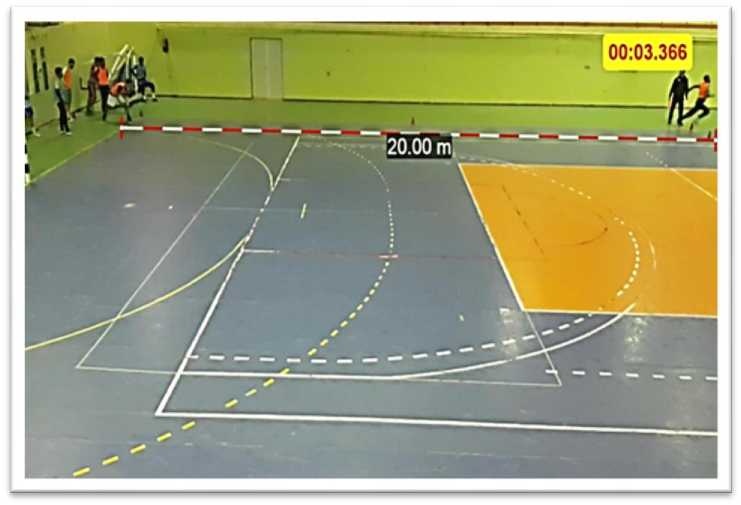
Figure 2. Participant Performing the Dribbling sprint test
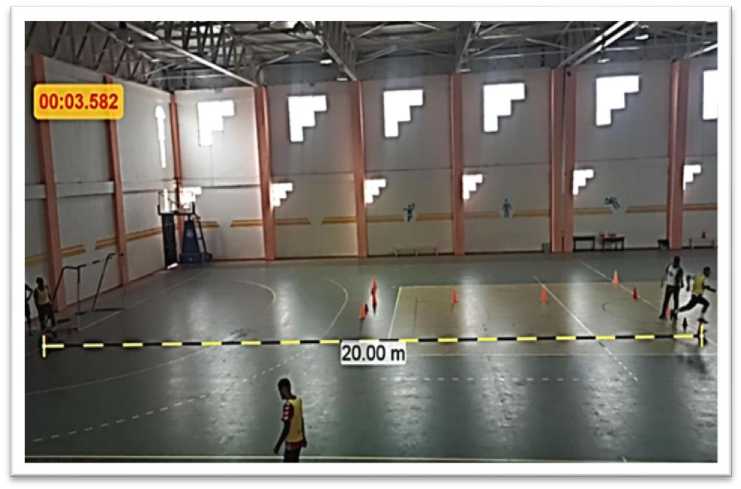
Results
The analysis of the speed test results revealed significant performance disparities between the indoor and outdoor teams. In the indoor team, 90% of players fall within the "Below Average" category, with the remaining 10% classified as "Insufficient." The outdoor team demonstrates even less favorable outcomes, with 77% categorized as "Insufficient" and 23% as "Below Average." Notably, no players from either team attained "Average" or higher ratings.
Table 3. Performance Evaluation Criteria
|
Time (Seconds) |
Evaluation |
|
Less Than 2.61 |
Excellent |
|
2.62 - 2.76 |
Very Good |
|
2.77 - 2.91 |
Good |
|
2.92 - 3.00 |
Average |
|
3.01 - 3.48 |
Below Average |
|
3.49 - 3.61 |
Insufficient |
|
Greater Than 3.61 |
Poor |
The time ranges exhibited variation between the teams. The indoor team displayed a broader range (3.04 to 3.54 s) compared to the outdoor team's narrower span (3.43 to 3.59 s). This distribution suggests that while the indoor team generally demonstrated marginally superior performance, it also exhibited greater variability in individual results. Conversely, despite showing more consistency, the outdoor team predominantly performed within lower-performance brackets.
Table 4. Sprint Test Results for Indoor and Outdoor Soccer Players
|
Player |
Outdoor Soccer Time (Seconds) |
Outdoor Soccer Evaluation |
Player |
Indoor Soccer Time (Seconds) |
Indoor Evaluation |
Soccer |
|
1 |
3,43 |
Below Average |
1 |
3,54 |
Insufficient |
|
2 |
3,49 |
Insufficient |
2 |
3,38 |
Below Average |
|
3 |
3,5 |
Insufficient |
3 |
3,14 |
Below Average |
|
4 |
3,51 |
Insufficient |
4 |
3,29 |
Below Average |
|
5 |
3,52 |
Insufficient |
5 |
3,11 |
Below Average |
|
6 |
3,53 |
Insufficient |
6 |
3,28 |
Below Average |
|
7 |
3,53 |
Insufficient |
7 |
3,04 |
Below Average |
|
8 |
3,54 |
Insufficient |
8 |
3,21 |
Below Average |
|
9 |
3,46 |
Below Average |
9 |
3,09 |
Below Average |
|
10 |
3,57 |
Insufficient |
10 |
3,29 |
Below Average |
|
11 |
3,44 |
Below Average |
|||
|
12 |
3,59 |
Insufficient |
|||
|
13 |
3,51 |
Insufficient |
Figure 3. Evaluation Distribution for Indoor and Outdoor Soccer
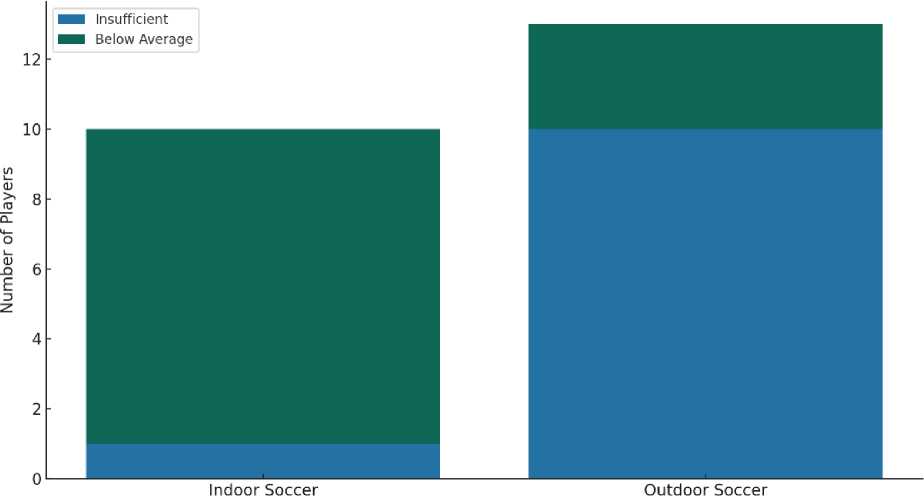
Soccer Group
Descriptive statistics (Table 3.) show that futsal players (n = 10) exhibit faster sprint times (M = 3.23 s, SD = 0.15 s) compared to outdoor soccer players (n = 13, M = 3.5 s, SD = 0.04 s), with notably greater variability in the futsal group.
Table 5. Descriptive Statistics of Sprint for Futsal and Outdoor Soccer
N Mean Median Std. Deviation Minimum Maximum Skewness Kurtosis
Futsal 1 3,23 3,24 0,15 3,04 3,54 0,69 0,3
Outdoor Soccer 3,5 3,51 0,04 3,43 3,59 -0,15 -0,25
The Shapiro-Wilk test indicated that sprint times were normally distributed for both futsal (W(10) = .947, p = .630) and outdoor soccer groups (W(13) = .968, p = .869). These results are consistent with the Kolmogorov-Smirnov test findings (futsal: D(10) = .163, p = .200; outdoor soccer: D(13) = .122, p = .200). The Q-Q plots visually supported these results, showing generally linear trends for both groups, with minor deviations at the extremes.
Tables 6. Normality Tests
|
group |
Kolmogorov-Smirnova |
Shapiro-Wilk |
|||||
|
Statistic |
df |
Sig. |
Statistic |
df |
Sig. |
||
|
SprinTime |
futsal |
,163 |
10 |
,200* |
,947 |
10 |
,630 |
|
outdoor soccer |
,122 |
13 |
,200* |
,968 |
13 |
,869 |
|
*. This is a lower bound of the true significance.
-
a. Lilliefors Significance Correction
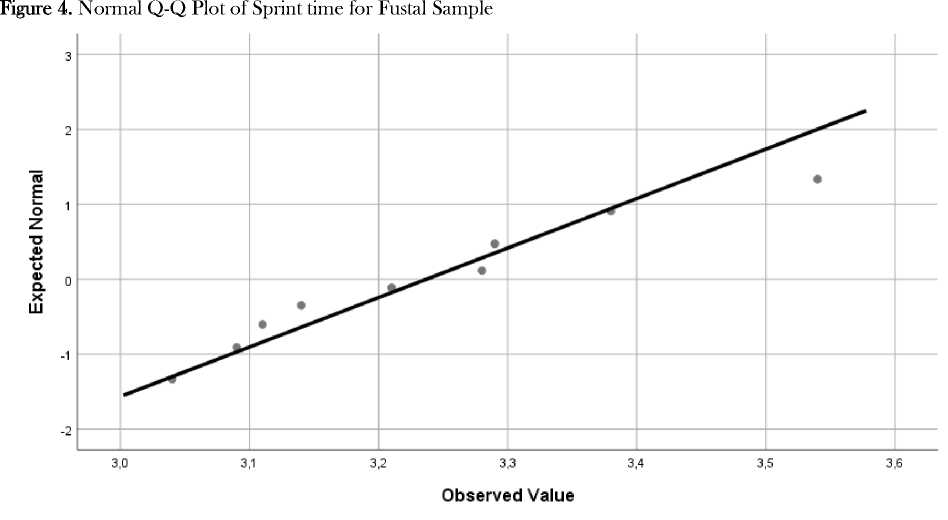
Figure 5. Normal Q-Q Plot of Sprint Time for Outdoor Soccer Sample
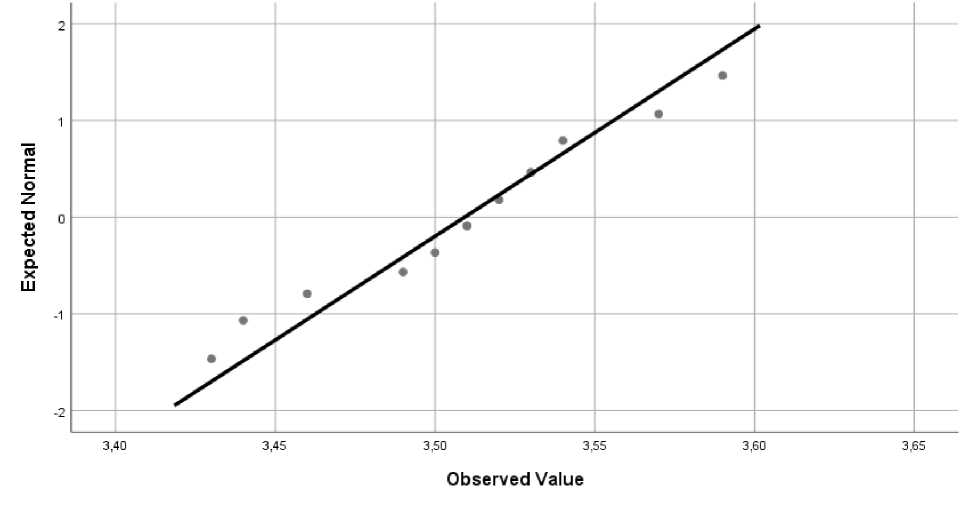
However, the histogram revealed some nuances not captured by the statistical tests. While the outdoor soccer group displayed a more symmetrical bell-shaped distribution characteristic of normality, the futsal group showed a wider, potentially multimodal distribution. This discrepancy between statistical tests and visual inspection suggests that while the data do not significantly deviate from normality, there may be underlying complexities in the futsal group's performance distribution.
Figure 6. Comparison of Sprint Distribution between Futsal and Outdoor Soccer Players
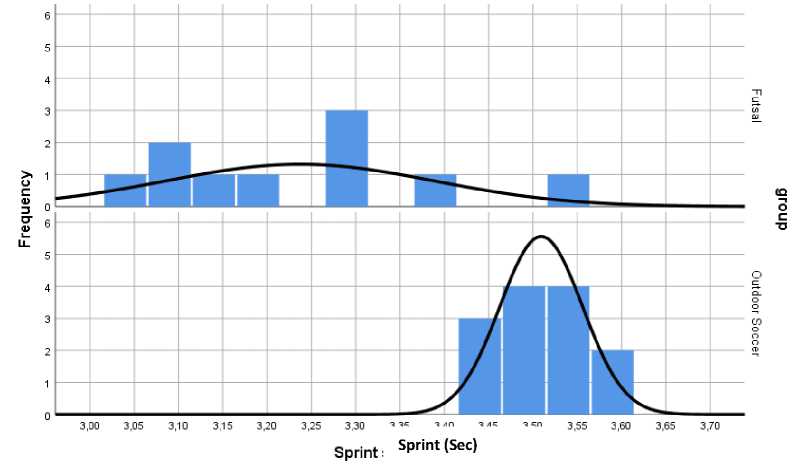
The box plot and histogram clearly illustrate the differences in central tendency and variability between the two groups. Futsal players demonstrated faster sprint times overall, with a median of approximately 3.25 seconds, compared to outdoor soccer players' median of about 3.50 seconds. However, futsal players also exhibited greater variability in performance, as evidenced by the larger interquartile range in the box plot and wider spread in the histogram. The outdoor soccer group, although generally slower, showed more consistent performance across players. This is visually apparent in the tighter clustering of sprint times in both the box plot and histogram. The box plot also revealed two outliers in the outdoor soccer group (labeled 11 and 22) with notably slower times, which were not immediately evident in the histogram owing to binning.
Figure 7. Boxplot Comparison of Sprint Times between Futsal and Outdoor Soccer Players
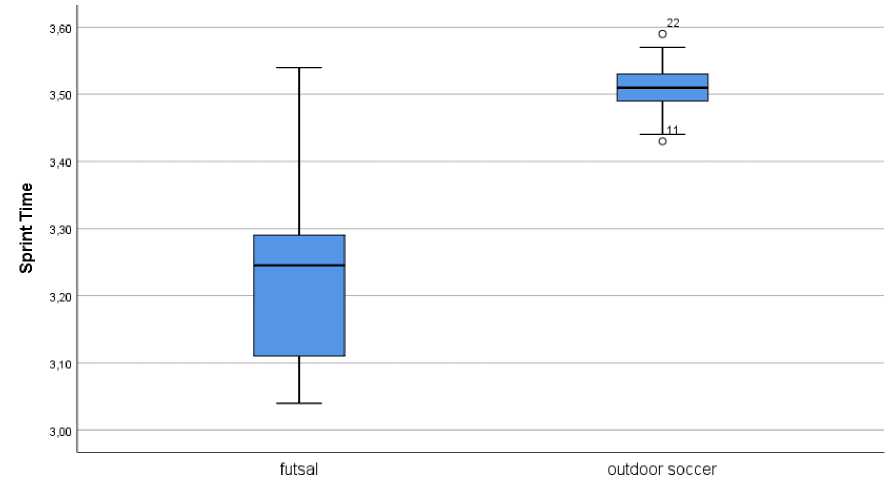
group
While formal normality tests (Shapiro-Wilk and Kolmogorov-Smirnov) suggested normal distributions for both groups, visual inspection of histograms and box plots revealed potential deviations from normality, particularly in the futsal group. Additionally, outliers in the outdoor soccer group and the relatively small sample sizes (futsal = 10, outdoor = 13) warrant cautious interpretation. Therefore, we conducted an independent samples t-test, adhering to the formal normality test results, and a Mann-Whitney U test as a non-parametric alternative. This conservative approach allows for a more robust analysis, accounting for potential violations of parametric assumptions while comprehensively examining the differences in sprint times between futsal and outdoor soccer players.
Levene's test for equality of variances was significant (F = 11.199, p = .003), indicating that the assumption of homogeneity of variances was violated. Therefore, we report the results for equal variances that are not assumed.
There was a significant difference in sprint times between futsal and outdoor soccer players (t (10.319) =-5.488, p <.001, d = 2.41). Futsal players demonstrated significantly faster sprint times than outdoor soccer players, with a mean difference of 0.27 seconds (95% CI [0.16, 0.38]). The effect size (Cohen's d = 2.41) indicates a large practical significance.
Considering the violation of the homogeneity of variance assumption, it is prudent to consider the results of the Mann-Whitney U test to corroborate these findings. The Mann-Whitney U test showed a statistically significant difference in sprint times between the groups (U = 119.50, p = .001 (asymptotic), p = .000 (exact)), with a large effect size (r=0.705). Futsal players demonstrated significantly faster sprint times (Mean Rank = 6.55) than outdoor soccer players (Mean Rank = 16.19).
The graphs visually support these findings, showing a clear separation in the distribution of sprint times between the two groups. Futsal players' sprint times were clustered at lower values (faster times) compared to outdoor soccer players' times, which were distributed at higher values (slower times).
These non-parametric results align with the findings of the independent-samples t-test, reinforcing the conclusion that there is a significant difference in sprint performance between futsal and outdoor soccer players, with futsal players demonstrating faster sprint times.
The consistency between the parametric (t-test) and non-parametric (Mann-Whitney U) results strengthens the reliability of our findings.
These results suggest that the nature of futsal, with its smaller playing area, may foster the development of superior sprint performance among its players. At the same time, outdoor soccer produces more consistent, albeit slower, sprint capabilities across its athletes, with occasional standout performances, as indicated by the box plot outlier.
Table 7. Ranks for Sprint Time by Sport Type
|
Group |
N |
Mean Rank |
Sum Of Ranks |
|
|
Futsal |
10 |
6,55 |
65,50 |
|
|
Sprint time |
Outdoor Soccer |
13 |
16,19 |
210,50 |
|
Total |
23 |
Table 8. Mann-Whitney U Test Results for Sprint Time Comparison
|
Total N |
23 |
|
Mann-Whitney U |
119.5 |
|
Wilcoxon W |
210.5 |
|
Test Statistic |
119.5) |
|
Standard Error |
16.109 |
|
Standardized Test Statistic |
3.383 |
|
Asymptotic Sig. (2-sided test) |
0.001 |
Exact Sig. (2-sided test) 0.000
Discussion
Statistical data demonstrating significant disparities in Sprint test performance favoring futsal players and our comparative analysis between the two sample groups suggest that this advantage stems from futsal's unique characteristics. This sport is distinguished by rapid motor activities executed within a compressed timeframe and at high intensity, as mandated by its regulations. These features include reduced playing area, increased proximity to opponents, and continuous swift transitions between defensive and offensive play. The condensed nature of futsal necessitates rapid decision-making and agile movements, potentially contributing to futsal players' superior performance in Sprint assessments.
Prior research and empirical studies centered on futsal have substantiated that this sport entails the rapid application of physical, skillful, and technical performance in training sessions and high-level competitions, surpassing the demands of outdoor soccer. Doucet (2014) asserted that futsal players frequently engage in defensive retreats and execute counterattacks at high velocities during various match phases, primarily through sprinting. Moreover, high-intensity bursts occur with greater frequency in futsal matches than in their outdoor soccer counterparts.
This finding aligns with the research conducted by de Matos et al. (2008) on the acceleration capacity of futsal and outdoor soccer players, which demonstrated statistically significant differences in Sprint (10-meter acceleration) favoring futsal players. The inherent characteristics of futsal, including its confined playing area and frequent transitions between offensive and defensive play, necessitate rapid decision-making and agile movements from the participants. These sport-specific demands may contribute to the superior performance of futsal players in Sprint assessments, as evidenced by the statistical data in our study and corroborated by the extant literature.
Kartal's study (2016), "Comparison of speed, agility, anaerobic strength, and anthropometric characteristics between futsal and outdoor soccer players," demonstrated statistically significant differences in the 30-meter sprint test favoring futsal players. This finding is corroborated by a substantial body of consistent research (Cuadrado-Peñafiel et al., 2014; Ba ^ kaya et al., 2018). These investigations uniformly reported superior average speed performance among futsal players compared to their outdoor soccer counterparts. The consistency of these results across multiple studies reinforces the evidence for enhanced speed capabilities in futsal players. This phenomenon is likely attributable to the sport's inherent demands for rapid acceleration and frequent transitions between offensive and defensive play in confined areas.
Hammoud et al. (2011) provided further corroboration in their comparative study of physical abilities and basic skills between five-a-side (futsal) and eleven-a-side outdoor soccer players. Their investigation of Sprint, utilizing a 30-meter test, yielded statistically significant differences favoring futsal players. This finding aligns with the previously mentioned body of research, reinforcing the observed trend of superior speed performance among futsal athletes.
This investigation further corroborates the cumulative evidence from prior studies, establishing a robust pattern of enhanced Sprint performance among futsal players relative to their outdoor soccer counterparts. The 30-meter test, a standardized metric for assessing short-distance sprint capability, elucidates the advantage futsal players have cultivated in rapid acceleration and swift locomotion over short distances. This observed superiority is likely attributable to the sport-specific demands of futsal, which necessitate frequent bursts of speed and agility within a confined playing area.
Apriantono et al. (2020), in their study "Speed and acceleration characteristics in a 60-meter sprint test between futsal and outdoor soccer players," demonstrated that futsal players exhibited superior running performance compared to their outdoor soccer counterparts. This enhanced performance was attributed to multiple factors inherent to the distinctive characteristics of each sport.
The superior performance of futsal players can be attributed to futsal's high-intensity movement patterns. Approximately 40% of activity occurs at maximum speed running, facilitated by confined playing areas, limited distances, and rapid transitions between defensive and offensive play. These elements collectively contribute to sustained high-intensity effort. Conversely, outdoor soccer involves approximately 70% of running activity at moderate intensity.
The compact nature of futsal, characterized by its restricted playing area and frequent high-intensity bursts, cultivates players' capacity for rapid acceleration and maintenance of high velocities over short distances. This observation aligns with previous research findings and further corroborates the hypothesis that futsal players exhibit superior Sprint compared to their outdoor soccer counterparts.
Conclusion:
The results revealed statistically significant differences favoring futsal players in the Sprint test. This analysis provides coaches and training professionals with an initial assessment of players' physical capacities, offering valuable insights for developing tailored training programs, formulating strategies to enhance physical and technical performance, and establishing benchmarks for evaluation and improvement.
The research findings indicate that velocity is the predominant factor in futsal. This sport offers players substantial opportunities to rapidly develop crucial physical abilities, technical proficiency, and cognitive capacities. Futsal is an effective training method for outdoor football players, enabling them to perform under constant pressure in confined spaces. This practice facilitates rapid transition performance, improved reaction time, enhanced decision-making processes, precise anticipation, and agile directional changes.
Futsal, also known as indoor soccer, is highly accessible and provides numerous opportunities for consistent engagement due to its imperviousness to inclement weather conditions. The minimal team composition of five players facilitates squad formation and enables equitable distribution of playing time among participants across diverse age demographics through the implementation of continuous substitutions during matches.
The fast-paced nature of futsal, with its smaller playing area and constant player involvement, creates an environment that demands and develops quick thinking and agile movements. Consequently, futsal serves not only as an engaging sport in its own right but also as an excellent training ground for improving overall soccer skills applicable to indoor and outdoor game variants.
Declaration of conflicting interests
The author declared no potential conflicts of interest with respect to the research, authorship, and/or publication of this article.
Funding
The author received no financial support for the research, authorship, and/or publication of this article.

